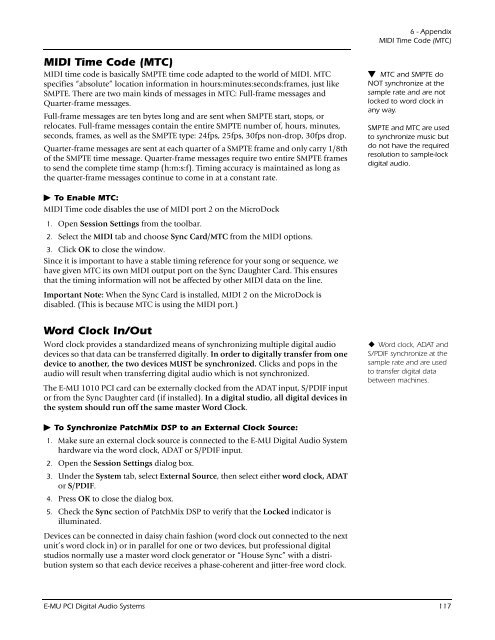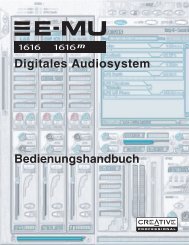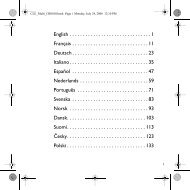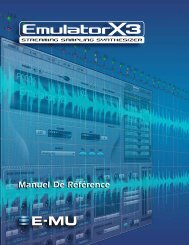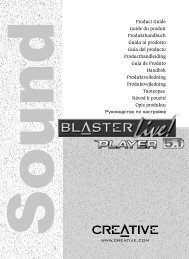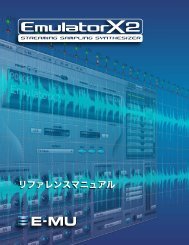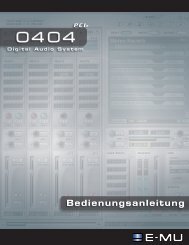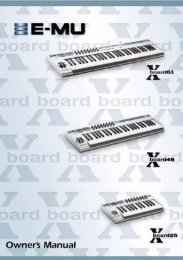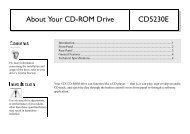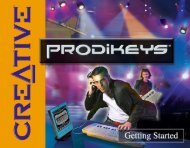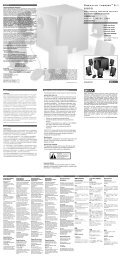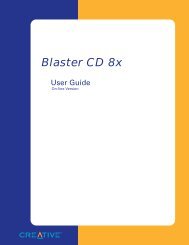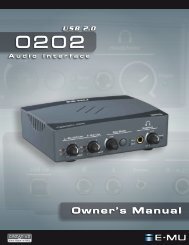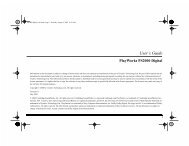You also want an ePaper? Increase the reach of your titles
YUMPU automatically turns print PDFs into web optimized ePapers that Google loves.
MIDI Time Code (MTC)<br />
MIDI time code is basically SMPTE time code adapted to the world of MIDI. MTC<br />
specifies “absolute” location information in hours:minutes:seconds:frames, just like<br />
SMPTE. There are two main kinds of messages in MTC: Full-frame messages and<br />
Quarter-frame messages.<br />
Full-frame messages are ten bytes long and are sent when SMPTE start, stops, or<br />
relocates. Full-frame messages contain the entire SMPTE number of, hours, minutes,<br />
seconds, frames, as well as the SMPTE type: 24fps, 25fps, 30fps non-drop, 30fps drop.<br />
Quarter-frame messages are sent at each quarter of a SMPTE frame and only carry 1/8th<br />
of the SMPTE time message. Quarter-frame messages require two entire SMPTE frames<br />
to send the complete time stamp (h:m:s:f). Timing accuracy is maintained as long as<br />
the quarter-frame messages continue to come in at a constant rate.<br />
To Enable MTC:<br />
MIDI Time code disables the use of MIDI port 2 on the MicroDock<br />
1. Open Session Settings from the toolbar.<br />
2. Select the MIDI tab and choose Sync Card/MTC from the MIDI options.<br />
3. Click OK to close the window.<br />
Since it is important to have a stable timing reference for your song or sequence, we<br />
have given MTC its own MIDI output port on the Sync Daughter Card. This ensures<br />
that the timing information will not be affected by other MIDI data on the line.<br />
Important Note: When the Sync Card is installed, MIDI 2 on the MicroDock is<br />
disabled. (This is because MTC is using the MIDI port.)<br />
Word Clock In/Out<br />
Word clock provides a standardized means of synchronizing multiple digital audio<br />
devices so that data can be transferred digitally. In order to digitally transfer from one<br />
device to another, the two devices MUST be synchronized. Clicks and pops in the<br />
audio will result when transferring digital audio which is not synchronized.<br />
The E-MU 1010 PCI card can be externally clocked from the ADAT input, S/PDIF input<br />
or from the Sync Daughter card (if installed). In a digital studio, all digital devices in<br />
the system should run off the same master Word Clock.<br />
To Synchronize PatchMix DSP to an External Clock Source:<br />
1. Make sure an external clock source is connected to the E-MU Digital Audio System<br />
hardware via the word clock, ADAT or S/PDIF input.<br />
2. Open the Session Settings dialog box.<br />
3. Under the System tab, select External Source, then select either word clock, ADAT<br />
or S/PDIF.<br />
4. Press OK to close the dialog box.<br />
5. Check the Sync section of PatchMix DSP to verify that the Locked indicator is<br />
illuminated.<br />
Devices can be connected in daisy chain fashion (word clock out connected to the next<br />
unit’s word clock in) or in parallel for one or two devices, but professional digital<br />
studios normally use a master word clock generator or “House Sync” with a distribution<br />
system so that each device receives a phase-coherent and jitter-free word clock.<br />
6 - Appendix<br />
MIDI Time Code (MTC)<br />
MTC and SMPTE do<br />
NOT synchronize at the<br />
sample rate and are not<br />
locked to word clock in<br />
any way.<br />
SMPTE and MTC are used<br />
to synchronize music but<br />
do not have the required<br />
resolution to sample-lock<br />
digital audio.<br />
Word clock, ADAT and<br />
S/PDIF synchronize at the<br />
sample rate and are used<br />
to transfer digital data<br />
between machines.<br />
E-MU PCI Digital Audio Systems 117


